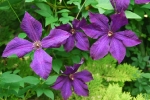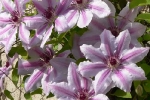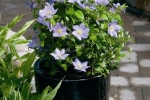The indoor Clematis plants have many colors and sizes, but generally they are purple, white, magenta and pink. All of them grow as well, so there is no reason, apart from the aesthetic to choose one color or another. Many people choose to plant in the garden more colors of the same plant.

Clematis thrives in areas with cold temperatures but sunny, especially in places where you can climb – especially on the cold roofs because they prefer rainy weather.
Clematis cirrhosis var. purpurascens is an herb garden that you definitely want to have in your garden in winter; it can bloom until the first frosty days with mild temperatures. Flowers have creamy white color, pendulous, and dark red spots inside the petals.
The clematis is grown in the northern hemisphere and southern Europe, China, Australia, North America and Central America. In Japan it is cultivated for a long time, while in Europe since the sixteenth century.
The plant’s name is derived from Greek, which means klema branch and relates to fragile wood of climbing branches.
Depending on the species, the leaves are opposite, sometimes covered with hairs, sometimes in a palm shape or with irregular edges. As any other climbing plants, the Clematises need semitransparent support at least 1.8 meters high (if more than that develops, it will be very large). They prefer cold air, wet, and grows best in places that receive the most sunlight, while the roots are protected from heat.
They should therefore be planted in fertile soil rich in humus, well drained, for the branches just to be in full sun while the roots covered in shadow. In winter you must cover the bottom of the plant with compost.
When planting, the roots should be placed approximately at 7.5 cm below the ground level to reduce risk of wilting. After planting, you have to cut the branches till they have 30 cm tall, leaving only a few more vigorous ones. At first the plant should be well connected to develop properly.
In general, the Clematis plant is not attacked by insects or by other pests. Sometimes aphids can invade the plant in spring, especially the fresh branches.
All the species of Clematis can also be replicated successfully from seed – after being harvested later there is a risk not to germinate.
Other varieties such as Clematis cirrhosis var. purpurascens can be propagated by cuttings.
Clematis Pictures Gallery



